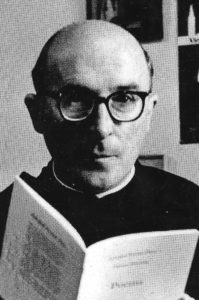- Born 1912; died 2000.
- Postulant of the Guild 1932-1933.
- Assistant in Print Works; later Carmelite Friar and Priest, scholar, writer and publisher.
Table of Contents
Life

The involvement of Brocard Sewell with the Guild began as a schoolboy in around 1926 when he was know as Michael Sewell; he answered an advertisement for some holiday work on the St Dominic’s Press and was taught the basics of typesetting by Hilary Pepler and a lifelong involvement with printing and publishing had begun. On leaving school, he went to work as general factotum in the London office of GK’s Weekly, the paper founded by GK Chesterton, which was the official organ of the Distributist League.
After leaving GK’s Weekly around 1928, he converted to Catholicism and returned to the St Dominic’s Press where he worked for Pepler for five years, becoming a postulant of the Guild in 1932 and leaving a year later to test his vocation with the Dominicans, whom he left shortly before joining the Royal Air Force during World War Two. Returning after the war, he resolved to join the religious life; he was first professed with the Austin Canons before becoming a Carmelite friar in 1952, taking the name Brocard and being ordained priest in 1954. He remained with the order for the rest of his life.
He was, however, a very unusual religious figure, being closely involved with the literary world. He wrote several books, often seeking to restore the reputation of forgotten writers, and maintained correspondence with many of the leading figures of the day. Furthermore, he founded the Carmelite St Albert’s Press.
Less creditably, he is reported to have been a member of the British Union of Fascists and was certainly a supporter of the repellent anti-Semite Oswald Moseley (he was often seen at Moseley meetings in Trafalgar Square), having been introduced by his great friend Henry Williamson. It would seem that his support for the Moseley never wavered – in the 1960s, the friar angered his religious superiors for voicing support for Mosley’s calls for the restriction of West Indian immigration. He often went to stay with the Moseleys at their grand Paris home, pretentiously named Le Temple de la Gloire.
His relationship with the Carmelite order was sometimes strained in other ways. He did not support the reforms of the second Vatican Council, being an advocate of the traditional Latin form of the Catholic liturgy. Conversely, he also opposed the Vatican’s ban on contraception articulated in the papal encyclical, Humanae Vitae, this time taking a more liberal stance. Following this and other controversies, he took himself off for two years to live at Capel-y-ffin Monastery, where Eric Gill had briefly settled after leaving the Guild.
Many years later and even more strangely, he also defended Eric Gill when revelations were made about his abuse of his daughters, referring to such acts as mere ‘peccadilloes’; as with Moseley, it seems he was prepared to put with a lot rather than withdraw his support for those whose friendships lent him prestige.
Sewell continued to follow Guild affairs to the end. He paid a final debt to Pepler with his last work of scholarship, The St Dominic’s Press Bibliography, printed at the Whittington Press in 1995. When the Guild finally closed, he wrote what may be called its obituary, published in the Catholic Herald (see below).
Article by Fr. Sewell about the Guild


